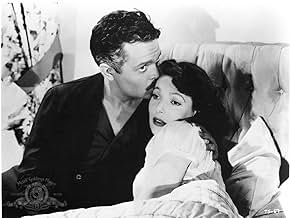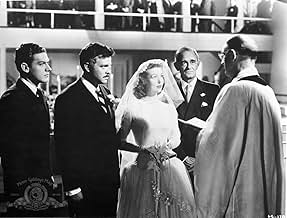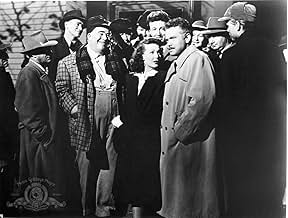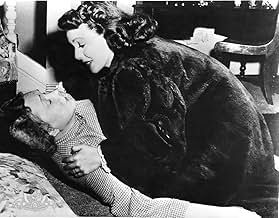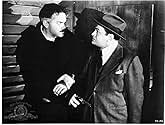CALIFICACIÓN DE IMDb
7.3/10
30 k
TU CALIFICACIÓN
Un investigador de la Comisión de Crímenes de Guerra viaja a Connecticut para buscar a un infame nazi.Un investigador de la Comisión de Crímenes de Guerra viaja a Connecticut para buscar a un infame nazi.Un investigador de la Comisión de Crímenes de Guerra viaja a Connecticut para buscar a un infame nazi.
- Dirección
- Guionistas
- Elenco
- Nominado a 1 premio Óscar
- 2 nominaciones en total
David Bond
- Student
- (sin créditos)
John Brown
- Passport Photographer
- (sin créditos)
Nancy Evans
- Undetermined Role
- (sin créditos)
Adolph Faylauer
- War Crimes Commision Member
- (sin créditos)
Fred Godoy
- Undetermined Role
- (sin créditos)
Theodore Gottlieb
- Fairbright
- (sin créditos)
Joseph Granby
- Undetermined Role
- (sin créditos)
Ethan Laidlaw
- Todd
- (sin créditos)
Opiniones destacadas
Infamous Nazi war criminal called Franz Kindler (Orson Welles) assumes a new respectable identity in a Midwestern little town following WWII , unaware that a government agent (Edward G. Robinson) from the Allied War Crimes commission patiently stalks him . But his name is fake and his past is tenebrous . The escaped Nazi sedately living and is about to marry a beautiful as well as unsuspecting young woman (Loretta Young) , daughter of a prestigious judge (Philip Merivale) . But later on , Kindler feels his past closing in and he will need his own spouse to help him elude capture .
Interesting Welles movie with plenty of thrills , fine character studio , terrific interpretations and suspense from start to finish . It holds the viewer's interest but admittedly has some flaws , naive moments and wobbles . But it is studded with splendid scenes like the furtive flight across the dockyards at the beginning , the killing in the forests and the final confrontation on the clock tower including the sword wielded mechanical figures that move when the hour begins to strike . The vast New England town exterior sets, including the church with its 124-foot clock tower, were constructed in Hollywood on the back lot of the United Artists studio located on Santa Monica Blvd . Shocking scenes when are shown images about Nazi crimes , in fact it was the first mainstream American movie to feature footage of Nazi concentration camps following World War II . Nice acting by Orson Welles as a Nazi criminal who feels fascination with antique clocks and sedately esconsced in a small Connecticut town when an investigator is tailing him . Edward G. Robinson is perfect as a Federal agent out to get him . However , Orson Welles originally wanted Agnes Moorehead to play the FBI part , then the studio said no and instead gave him Edward G. Robinson . Furthermore , Loretta Young as attractive wife and Richard Long as brother give nicely understated interpretations . Suspenseful and thrilling musical score by Bronislau Kaper . Extremely well made camera-work throughout ; being shot in black and white filled with lights and darks by excellent cameraman Russell Metty . It is also available in horrible computer-colored version .
¨The stranger¨ was efficiently produced by Sam Spiegel and well directed by Orson Welles in 95 minutes runtime , being the only film directed by him to show a profit in its original release . However , Orson has stated that this is his least favorite of his films . Welles was a genius who had a large as well as problematic career . In 1938 he produced "The Mercury Theatre on the Air", famous for its broadcast version of "The War of the Worlds" . His first film to be seen by the public was ¨Ciudadano Kane¨ (1941), a commercial failure , but regarded by many as the best film ever made , along with his following movie , ¨The magnificent Ambersons¨ . After that , he directed this ¨The stranger¨ with an over-pitched acting by the same Welles and often described as his worst . He subsequently directed Shakespeare adaptation such as ¨Macbeth¨ , ¨Othelo¨ and his highly enjoyable ¨Chimes at Midnight¨ or ¨Falstaff¨ . He also performed a lot of films , Orson Welles interpreted for getting financing to shoot his pictures , as he played several exotic characters such as ¨The Tartari¨ , ¨Saul¨ , ¨Cagliostro¨ , ¨Cesare Borgia¨ and ¨Black rose¨ . Many of his next films were commercial flops and he exiled himself to Europe in 1948 . In 1956 he directed ¨Touch of evil¨ (1958) ; it failed in the U.S. but won a prize at the 1958 Brussels World's Fair . In 1975, in spite of all his box-office failures , he received the American Film Institute's Lifetime Achievement Award , and in 1984 the Directors Guild of America awarded him its highest honor, the D.W. Griffith Award . His reputation as a film maker has climbed steadily ever since .
Interesting Welles movie with plenty of thrills , fine character studio , terrific interpretations and suspense from start to finish . It holds the viewer's interest but admittedly has some flaws , naive moments and wobbles . But it is studded with splendid scenes like the furtive flight across the dockyards at the beginning , the killing in the forests and the final confrontation on the clock tower including the sword wielded mechanical figures that move when the hour begins to strike . The vast New England town exterior sets, including the church with its 124-foot clock tower, were constructed in Hollywood on the back lot of the United Artists studio located on Santa Monica Blvd . Shocking scenes when are shown images about Nazi crimes , in fact it was the first mainstream American movie to feature footage of Nazi concentration camps following World War II . Nice acting by Orson Welles as a Nazi criminal who feels fascination with antique clocks and sedately esconsced in a small Connecticut town when an investigator is tailing him . Edward G. Robinson is perfect as a Federal agent out to get him . However , Orson Welles originally wanted Agnes Moorehead to play the FBI part , then the studio said no and instead gave him Edward G. Robinson . Furthermore , Loretta Young as attractive wife and Richard Long as brother give nicely understated interpretations . Suspenseful and thrilling musical score by Bronislau Kaper . Extremely well made camera-work throughout ; being shot in black and white filled with lights and darks by excellent cameraman Russell Metty . It is also available in horrible computer-colored version .
¨The stranger¨ was efficiently produced by Sam Spiegel and well directed by Orson Welles in 95 minutes runtime , being the only film directed by him to show a profit in its original release . However , Orson has stated that this is his least favorite of his films . Welles was a genius who had a large as well as problematic career . In 1938 he produced "The Mercury Theatre on the Air", famous for its broadcast version of "The War of the Worlds" . His first film to be seen by the public was ¨Ciudadano Kane¨ (1941), a commercial failure , but regarded by many as the best film ever made , along with his following movie , ¨The magnificent Ambersons¨ . After that , he directed this ¨The stranger¨ with an over-pitched acting by the same Welles and often described as his worst . He subsequently directed Shakespeare adaptation such as ¨Macbeth¨ , ¨Othelo¨ and his highly enjoyable ¨Chimes at Midnight¨ or ¨Falstaff¨ . He also performed a lot of films , Orson Welles interpreted for getting financing to shoot his pictures , as he played several exotic characters such as ¨The Tartari¨ , ¨Saul¨ , ¨Cagliostro¨ , ¨Cesare Borgia¨ and ¨Black rose¨ . Many of his next films were commercial flops and he exiled himself to Europe in 1948 . In 1956 he directed ¨Touch of evil¨ (1958) ; it failed in the U.S. but won a prize at the 1958 Brussels World's Fair . In 1975, in spite of all his box-office failures , he received the American Film Institute's Lifetime Achievement Award , and in 1984 the Directors Guild of America awarded him its highest honor, the D.W. Griffith Award . His reputation as a film maker has climbed steadily ever since .
Stylish noir trading on public's concern with escaped Nazis following WWII. First part is especially intriguing since we can't be sure what's happening or who Franz Kindler is. The atmosphere is typically Wellesian— shadows galore, imaginative camera set-ups, along with dramatic use of sound. Two features, however, standout for me.
Once the plot comes into focus, we know Kindler (Welles) must do away with Meinicke (Shayne), but how. The forest scene is inspired, more menacing I think than the finale. The two men are on bended knee, in apparent communion with the forces of good, except one of them is not.
Second is Welles' depiction of small town America through druggist Potter (House, in a splendid performance). Grossly over-weight, he sits all day in front of his checkerboard, hoping to entice some sucker into a game, so he can cheat them out of a quarter. Worse, he makes customers serve themselves, apparently so he won't have to move his bulk. Not exactly the neighborly small town of Shadow of a Doubt (1943), for example.
Given the movie's many arresting features, I'm not sure why its profile isn't higher among both noirs and the Welles canon. My best guess concerns a general absence of ambiguity among both characters and situations. Instead, the screenplay is a straight pursuit film of good vs. evil that makes good use of cat and mouse, and of atmosphere, but is unexceptional in storyline. So if you're looking for stylish suspense without tricky moral complications, this is a movie to catch.
Once the plot comes into focus, we know Kindler (Welles) must do away with Meinicke (Shayne), but how. The forest scene is inspired, more menacing I think than the finale. The two men are on bended knee, in apparent communion with the forces of good, except one of them is not.
Second is Welles' depiction of small town America through druggist Potter (House, in a splendid performance). Grossly over-weight, he sits all day in front of his checkerboard, hoping to entice some sucker into a game, so he can cheat them out of a quarter. Worse, he makes customers serve themselves, apparently so he won't have to move his bulk. Not exactly the neighborly small town of Shadow of a Doubt (1943), for example.
Given the movie's many arresting features, I'm not sure why its profile isn't higher among both noirs and the Welles canon. My best guess concerns a general absence of ambiguity among both characters and situations. Instead, the screenplay is a straight pursuit film of good vs. evil that makes good use of cat and mouse, and of atmosphere, but is unexceptional in storyline. So if you're looking for stylish suspense without tricky moral complications, this is a movie to catch.
The Stranger was directed by Orson Welles but he did not adapt it to the screen. Although this is seen as a detraction from the whole by some who have seen it, I believe that Welles' deft directing and penetrating acting is what makes this a Welles film for my taste. He was never a facile actor - but he uses his usual wooden countenance here to the advantage of this role.
Another thing that fascinates me is the underrated status of this engrossing thriller. The action and suspense builds and builds to a peak of excitement that few movies can reach without lots of special effects and Foley work these days. This movie fascinates at every turn without ever seeming as if we are watching art. But art it was in Welles' direction and gentle handling of the unravelling.
Edward G. Robinson is the subtle but welcome prize we receive from this outing. The undercurrents of the horrors that have just come before this movie was made and its actions can be seen seething within his duty to find hidden Nazis. He is methodical and intelligent, it so difficult to see the difference between Robinson the man and Robinson the actor here. He is such a talent that we often mistake his ease for something else but acting -- and of acting he was a master. Plainly seen here as a gift to all of us.
What I like about this and many other good films is how facts are revealed slowly, layer by layer.
Loretta Young was good as the innocent young girl who believes that marriage is a sacred institution, that life has a course to follow which will not be derailed and finds it hard to accept the truth of the horrors behind her marriage.
It was mildly amusing to see a very young Richard Long as the open-minded young man with whom Robinson's character confides certain facts.
I recommend it to fans of psychological thrillers, mysteries and of course, of Mr. Orson Welles. So sad that the studio heads were such disingenuous towards this utter genius of a man who deserved more earnest accolades in his life.
THE STRANGER is not glittering masterpiece but it's a hell of great story that I do not tire of watching...and seeing each piece of the puzzle fall into place.
What MORE could an intelligent person want from a movie?
Another thing that fascinates me is the underrated status of this engrossing thriller. The action and suspense builds and builds to a peak of excitement that few movies can reach without lots of special effects and Foley work these days. This movie fascinates at every turn without ever seeming as if we are watching art. But art it was in Welles' direction and gentle handling of the unravelling.
Edward G. Robinson is the subtle but welcome prize we receive from this outing. The undercurrents of the horrors that have just come before this movie was made and its actions can be seen seething within his duty to find hidden Nazis. He is methodical and intelligent, it so difficult to see the difference between Robinson the man and Robinson the actor here. He is such a talent that we often mistake his ease for something else but acting -- and of acting he was a master. Plainly seen here as a gift to all of us.
What I like about this and many other good films is how facts are revealed slowly, layer by layer.
Loretta Young was good as the innocent young girl who believes that marriage is a sacred institution, that life has a course to follow which will not be derailed and finds it hard to accept the truth of the horrors behind her marriage.
It was mildly amusing to see a very young Richard Long as the open-minded young man with whom Robinson's character confides certain facts.
I recommend it to fans of psychological thrillers, mysteries and of course, of Mr. Orson Welles. So sad that the studio heads were such disingenuous towards this utter genius of a man who deserved more earnest accolades in his life.
THE STRANGER is not glittering masterpiece but it's a hell of great story that I do not tire of watching...and seeing each piece of the puzzle fall into place.
What MORE could an intelligent person want from a movie?
It's quite interesting to see two acting legends like Orson Welles and Edward G. Robinson working together, and with a cast that includes those two plus Loretta Young, along with an interesting story, "The Stranger" is a pretty good thriller.
Welles and Robinson play an interesting cat-and-mouse game in the search for a former Nazi who is hiding out in a peaceful Connecticut town. It's fair to point out, as others have done, that the dialogue at times leaves a little to be desired, but Welles and Robinson have more than enough ability to carry it off anyway.
Loretta Young has a difficult role as the wife of Welles's character. The script does her no favors, either, but she gives a creditable performance as a character who is important to the story. Among the supporting cast, Billy House particularly stands out, getting surprisingly good mileage out of his role as the store-keeper.
Perhaps the most creative aspect of the movie is the effective use of the clock tower, both as a plot device and as an idea, along with the related themes of clocks and time. The tense climax makes good use of all of these elements.
Welles and Robinson were both parts of so many outstanding movies that sometimes their merely good movies can seem to suffer by comparison. As long as you don't try to compare "The Stranger" with some other film, but just watch it for itself, it's a good thriller and an entertaining movie.
Welles and Robinson play an interesting cat-and-mouse game in the search for a former Nazi who is hiding out in a peaceful Connecticut town. It's fair to point out, as others have done, that the dialogue at times leaves a little to be desired, but Welles and Robinson have more than enough ability to carry it off anyway.
Loretta Young has a difficult role as the wife of Welles's character. The script does her no favors, either, but she gives a creditable performance as a character who is important to the story. Among the supporting cast, Billy House particularly stands out, getting surprisingly good mileage out of his role as the store-keeper.
Perhaps the most creative aspect of the movie is the effective use of the clock tower, both as a plot device and as an idea, along with the related themes of clocks and time. The tense climax makes good use of all of these elements.
Welles and Robinson were both parts of so many outstanding movies that sometimes their merely good movies can seem to suffer by comparison. As long as you don't try to compare "The Stranger" with some other film, but just watch it for itself, it's a good thriller and an entertaining movie.
Who says that fear of terrorism is a new development, post 9/11. Imagine the fears and exposed nerve endings of the average towns person living in the shadow of World War II. There was the fear of infiltration by the Nazis with their secret agents, blending in with our everyday citizens. Orson Welles plays just such a guy. He is kind, pleasant, quiet, and very dangerous. He even sets about marrying a woman as part of his secret plot. Edward G. Robinson, who normally would have been the heavy, plays a tired, hard working investigator who is leaving no stone unturned. The plot is intricate, though predictable, and the whole thing is hard to take your eyes off. Welles was a great director, but perhaps an even better actor. He keeps this thing going, raising it above the common fair of the time. The writing keeps the good guys at bay, but the clues continue to sit there, ripe for discovery. The clock tower is a great symbol, continuing to remind us of the urgency of everything. The dramatic irony presented makes us continually uncomfortable. We are treated to the movements and activities of the villain, and being let in, it makes everything more enjoyable. See this if you can.
¿Sabías que…?
- TriviaThis was the first mainstream American movie to feature footage of Nazi concentration camps following World War II.
- ErroresTwo palm trees are visible in the first scene depicting the fictional Connecticut town.
- Citas
Mr. Wilson: Well, who but a Nazi would deny that Karl Marx was a German because he was a Jew?
- Versiones alternativasAlso available in a computer-colorized version.
- ConexionesEdited into Ninja the Mission Force: Citizen Ninja (2012)
Selecciones populares
Inicia sesión para calificar y agrega a la lista de videos para obtener recomendaciones personalizadas
- How long is The Stranger?Con tecnología de Alexa
Detalles
Taquilla
- Presupuesto
- USD 1,034,000 (estimado)
- Tiempo de ejecución1 hora 35 minutos
- Color
- Relación de aspecto
- 1.37 : 1
Contribuir a esta página
Sugiere una edición o agrega el contenido que falta

Principales brechas de datos
By what name was El extraño (1946) officially released in India in Hindi?
Responda


